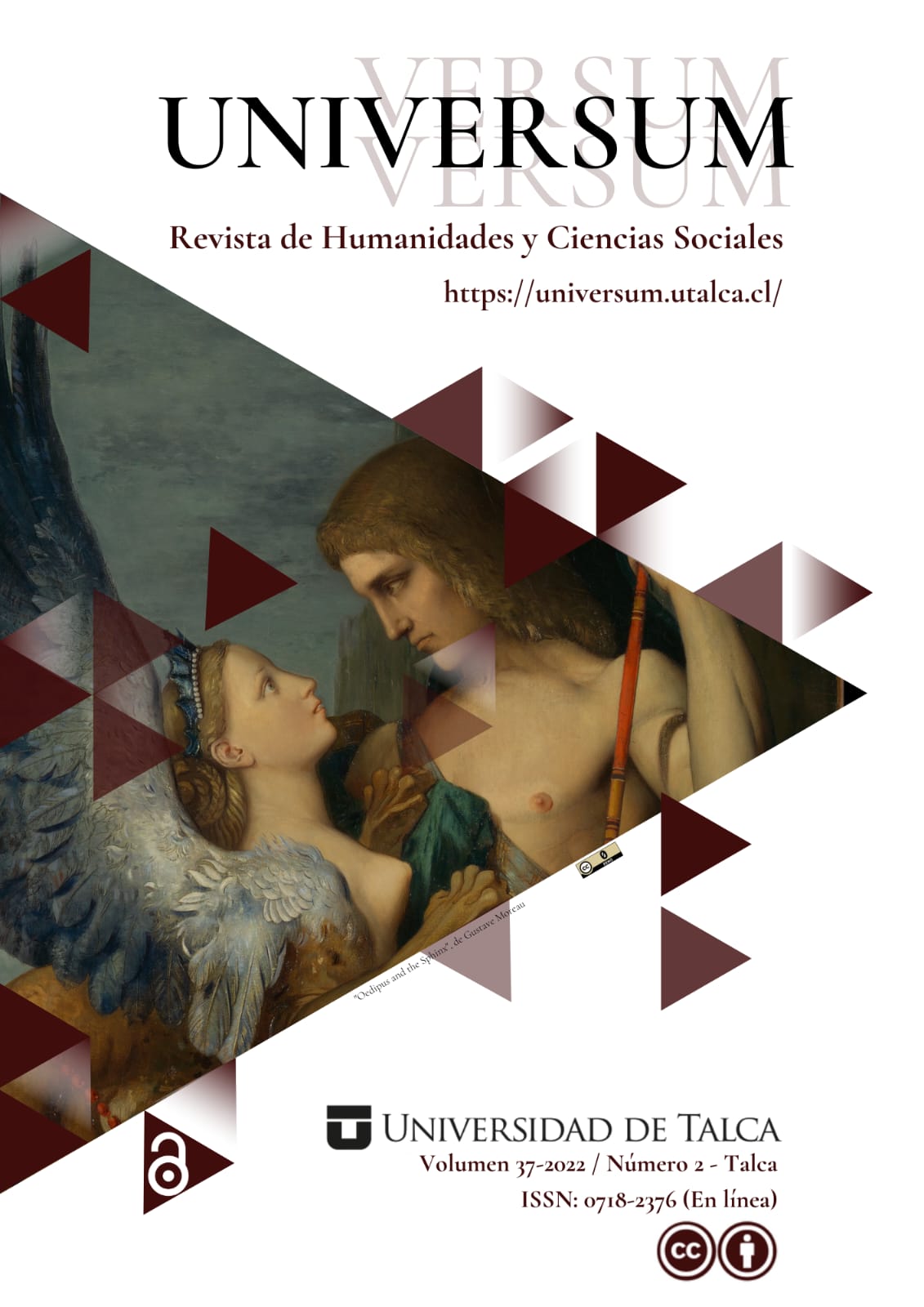Resumen
En este trabajo analizaré la importancia que las maravillas tuvieron en la configuración sensorial carolingia en el siglo IX, en especial cómo contribuyeron al establecimiento de una comunidad sensorial a partir de la generación y circulación de saberes y de prácticas, en las que se cruzan los sentidos humanos y el mundo animal.
Citas
Bartlett, R. (2008). The natural and the supernatural in the Middle Ages. Cambridge University.
Bildhauer, B. y Mills, R. (2003). Introduction: Conceptualizing the Monstrous. En B. Bildhauer y R. Mills (Eds.), The monstrous Middle Ages (pp. 1-27). University of Toronto.
Classen, C. (1990). Sweet Colors, Fragrant Songs: Sensory Models of the Andes and the Amazon. American Ethnologist, 17(4), 722-735.
Classen, C. (1993). Worlds of Sense: Exploring the Senses in History and Across Cultures. Routledge.
Coronado Schwindt, G. (2020). Los estudios sensoriales y la Edad Media: planteos historiográficos, desafíos y proyecciones. Revista de Historiografía, 34, 277-298.
Depreux, P., Lebecq, S., Perrin, M. y Szerwiniack, O. (Eds.) (2010). Raban Maur et son temps. Turnhout.
Draelants, I. (2015). Modèles épistémologiques de l’enquête encyclopédique sur la nature des choses ob posteritatis utilitatem. En Société des historiens médiévistes de l’Enseignement supérieur public (Eds), Apprendre, produire, se conduire: le modèle au Moyen ge (pp. 235-260). De la Sorbonne.
Dutton, P. (2004). Charlemagne, King of Beasts. En P. Dutton, In Charlemagne’s Mustache and Other Cultural Clusters of a Dark Age (pp. 43-68). Palgrave Macmillan.
Heyse, E. (1969). Hrabanus Maurus Enzyklopädie “De rerum naturis”. Untersuchungen zu den Quellen und zur Methode der Kompilation. Arbeo-Gesellschaft.
Kappler, C. (1986). Monstruos, demonios y maravillas a fines de la Edad Media. Akal.
Korsmeyer, C. (2002). El sentido del gusto. Comida, estética y filosofía. Paidós.
Le Goff, J. (2008). Lo maravilloso y lo cotidiano en el Occidente medieval. Gedisa.
Maurette, P. (2015). El sentido olvidado. Ensayos sobre el tacto. Ediciones Mardulce.
Mauss, M. (2009). Ensayo sobre el don. Formación y función del intercambio en las sociedades arcaicas. Katz.
McKitterick, R. (Ed.) (1993). Carolingian Culture: Emulation and Innovation. Cambridge University.
Mittman, A. (2012). Introduction: the impact of monsters and monster studies. En A. Mittman y P. Dendle (Eds.), The Ashgate Research Companion to Monsters and the Monstrous (pp. 1-14). Ashgate Variorum.
Newhauser, R. (2015). The Senses, the Medieval Sensorium, and Sensing (in) the Middle Ages. En A. Classen (Ed.), Handbook of Medieval Culture. Fundamental Aspects and Conditions of the European Middle Ages (vol. 3, pp. 1559-1575). De Gruyter.
Newhauser, R. (2021). Anthologizing the Medieval Senses: A Methodological Overview. Postmedieval, 12(1), 123-133.
Ortúzar Escudero, M. J. (2016). Die Sinne in den Schriften Hildegards von Bingen: Ein Beitrag zur Geschichte der Sinneswahrnehmung. Anton Hiersemann.
Ortúzar Escudero, M. J. (2019). Los cinco sentidos en las Etimologías de Isidoro de Sevilla (ca. 560- ca. 636). Historias del Orbis Terrarum, 23, 67-86.
Ortúzar Escudero, M. J. (2021). Asir lo intangible. Reflexiones sobre la historia de los sentidos. En G. Rodríguez (Dir.), La Edad Media a través de los sentidos (pp. 7-22). Universidad Nacional de Mar del Plata.
Palazzo, É. (2014). L’invention chrétienne des cinq sens dans la liturgie et l’art au Moyen ge. Du Cerf.
Palazzo, É. (2019). Les cinq sens, le corps et l'esprit. Mirabilia: Revista Eletrônica de História Antiga e Medieval, 28, 306-330.
Paterson, M. y Glass, M. (2020). Seeing, Feeling and Showing “Bodies-in-place”: Exploring Reflexivity and the Multisensory Body through Videography. Social and Cultural Geography, 21(1), 1-24.
Phelan, O. (2014). Conclusion: Loss and Legacy. En O. Phelan, The Formation of Christian Europe. The Carolingians, Baptism, and the Imperium Christianum (pp. 262-277). Oxford University.
Rábano Mauro (2018). Sobre el Universo (C. Domínguez, Trad.). Universidad Nacional de Mar del Plata.
Rodríguez, G. (2019a). La conformación de una comunidad emocional y sensorial carolingia. Mirabilia: Revista Eletrônica de História Antiga e Medieval, 29(2), 252-281.
Rodríguez, G. (2019b). A Sensory Reading of Rabanus Maurus’ De Universo. En J. Kume (Ed.), Beyond the Seas: A Medievalists’ Meeting in Tokyo (pp. 25-36). Tokyo University of Foreign Studies - Institute for Global Area Studies.
Rodríguez, G. (2021a). La importancia de los animales en la configuración sensorial carolingia. Intus-Legere Historia, 15(1), 222-236.
Rodríguez, G. (2021b). La configuración de una comunidad sensorial carolingia. En G. Rodríguez (Dir.), La Edad Media a través de los sentidos (pp. 23-57). Universidad Nacional de Mar del Plata.
Rodríguez, G. (2021c). Comunidad sensorial. En G. Rodríguez (Dir.), Sensonario: diccionario de términos sensoriales (pp. 1-3). Universidad Nacional de Mar del Plata. https://cutt.ly/mCOvAlt
Rodríguez, G. (2021d). Marca sensorial. En G. Rodríguez (Dir.), Sensonario: diccionario de términos sensoriales (pp. 1-2). Universidad Nacional de Mar del Plata. https://cutt.ly/kCOvGWS
Rodríguez, G. y Coronado Schwindt, G. (2017). La intersensorialidad en el Waltharius. Cuadernos Medievales, 23, 31-48.
Sears, E. (1990). Louis the Pious as Miles Christi. The Dedicatory Image in Hrabanus Maurus’s De laudibus. En P. Godman y R. Collins (Eds.), Charlemagne’s Heir. New Perspectives on the Reign of Louis the Pious (814-840) (pp. 605-628). Clarendon.
Seremetakis, N. (2008). The Memory of the Senses: Historical Perception, Commensal Exchange and Modernity. Society for Visual Anthropology Newsletter, 9(2), 2-18.
Simmel, G. (2014). Sociología: estudios sobre las formas de socialización. Fondo de Cultura Económica.
Smith, M. (2007). Sensing the Past. Seeing, Hearing, Smelling, Tasting, and Touching in History. University of California.
Smith, M. (2021). A Sensory History Manifesto. Penn State University.
Steel, K. (2012). Centaurs, satyrs, and cynocephali: medieval scholarly teratology and the question of the human, En A. Mittman y P. Dendle (Eds.), The Ashgate Research Companion to Monsters and the Monstrous (pp. 257-274). Ashgate Variorum.
Stone, R. (2012). Morality and Masculinity in the Carolingian Empire. Cambridge University.
Synnott, A. (2003). Sociología del olor. Revista Mexicana de Sociología, 65(2), 431-464.
Webb, L. (2021). Animal Feelings: Senses of the Carolingian Hunt. Postmedieval, 12(1), 153-171.
Williams, D. (1996). Deformed Discourse: the function of the Monster in Mediaeval Thought and Literature. University of Exeter.

Esta obra está bajo una licencia internacional Creative Commons Atribución-NoComercial 4.0.


